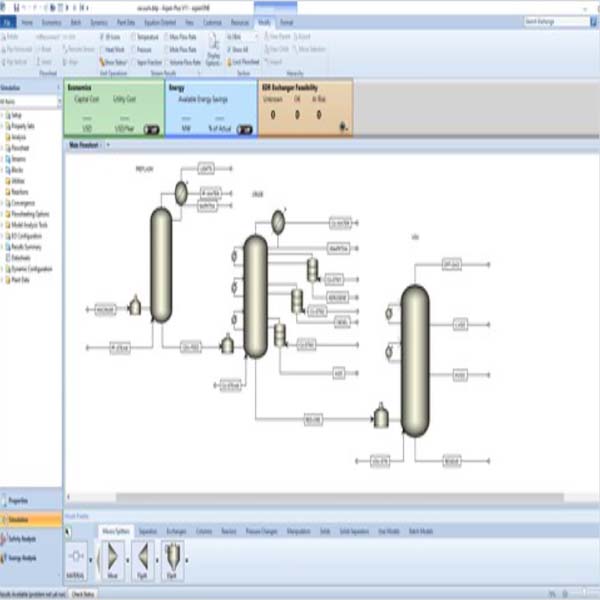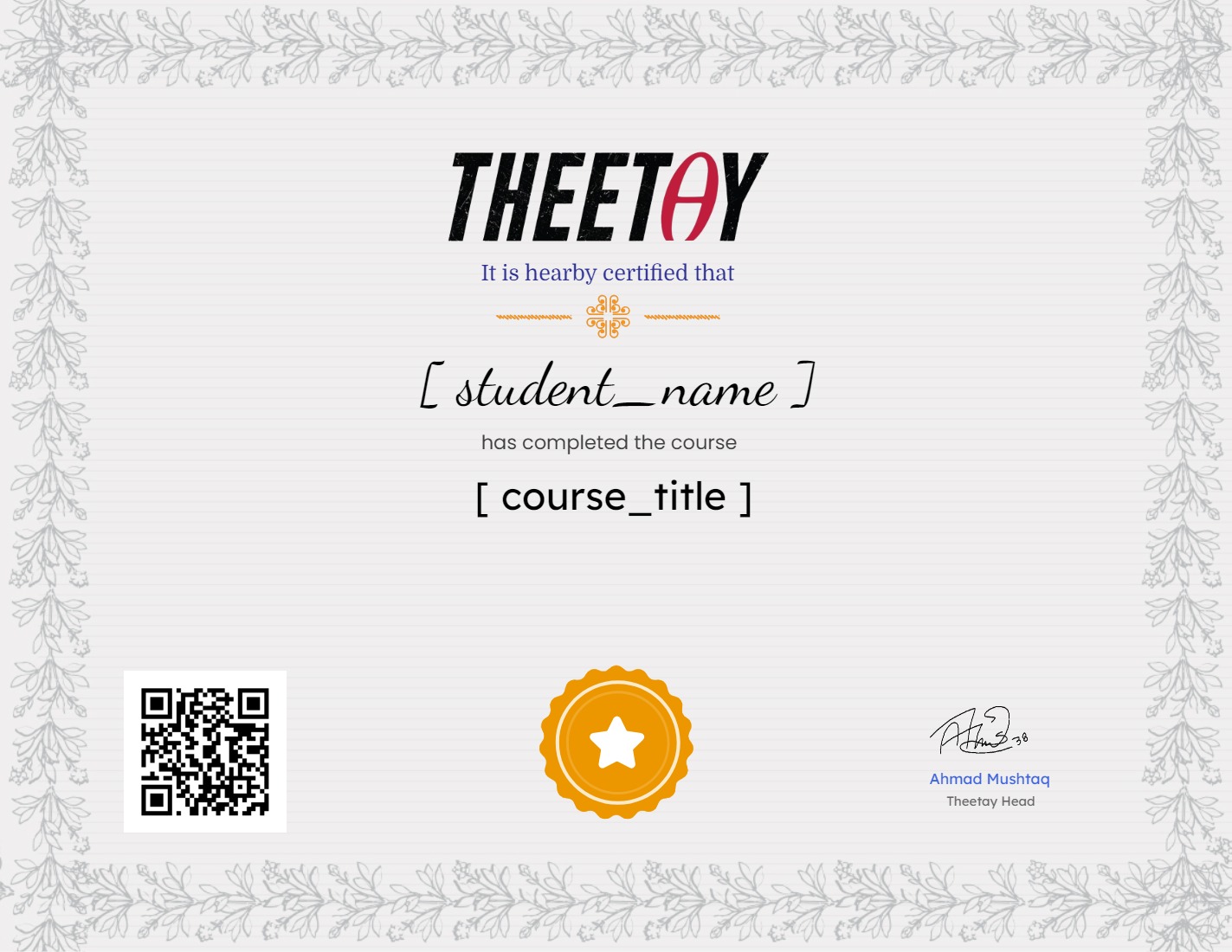Aspen Plus V11 Masterclass : From beginner to advanced user

About Course
Unlock the power of chemical engineering simulation with this comprehensive **Aspen Plus** online course, completely **FREE**! This course, offered by top learning platforms like **Udemy**, **Udacity**, **Coursera**, **MasterClass**, **NearPeer**, and more, equips you with the skills to become a proficient Aspen Plus user.
**Master essential concepts and practical applications**:
- 9 Sections covering flash separation, distillation columns, liquid-liquid extraction, heat exchangers, piping systems, chemical reactors, solids handling, model analysis tools, and Aspen Plus safety analysis.
- Build and optimize steady-state simulation models for process equipment like distillation columns, reactors, pumps, compressors, and piping systems.
- Expert guidance on Aspen Plus features like material balance, simulation environments, report function, and model analysis tools.
- Hands-on learning through practical examples and workshops to develop your skills.
- Advanced techniques like equipment rating, case studies, sensitivity analysis, process optimization, and property analysis.
Benefits of this free course:
- Completely free access to valuable knowledge and skills.
- Learn from experienced instructors who are experts in chemical engineering and Aspen Plus simulation.
- Enhance your career prospects and gain a competitive edge in the chemical engineering industry.
- Learn at your own pace, anytime and anywhere.
Don’t miss this opportunity to become an **Aspen Plus expert**. Enroll today and elevate your chemical engineering skills for **free**!
What Will You Learn?
- Identify the benefits of process simulation using Aspen Plus
- Describe the capabilities of Aspen Plus
- Familiarize yourself with Aspen Plus graphical user interface and organizational structure
- Learn the basic concepts necessary for creating simulations in Aspen Plus
- Enter necessary elements to fully define a Fluid Package
- Select the appropriate property method for your application
- Define material streams and connect unit operations to build a flowsheet
- Modify and set desired units of measure
- Review stream analysis options
- Add and connect unit operations to build a flowsheet
- Use the Report Manager to create custom unit operation and stream reports
- Use Aspen Plus to perform property analysis of pure components and mixtures
- Use Aspen Plus in thermodynamics instruction for Vapor-Liquid, Liquid-Liquid and Vapor-Liquid-Liquid Equilibrium calculations
- Build, navigate and optimize steady state simulation models using Aspen Plus
- Utilize a wide variety of unit operation models and calculation tools to model process equipment
- Evaluate the performance of existing equipment by leveraging the equipment rating capabilities of Aspen Plus
- Perform Case Studies to determine the optimum operating points for a process
- Design, revamp and debottleneck process equipment
- Use the Model Analysis Tools to run sensitivity analysis and optimize your process
- Calculate process performance and thermophysical data with user subroutines in Fortran
- Investigate reasons why a simulation may produce poor results or errors
- Use suggested tips to debug a variety of simulations
- Understand best practices and learn how to troubleshoot simulations
- Identify and explain the various classes of distillation and separations models available in Aspen Plus
- Gain the skills and knowledge to model distillation, separation and extraction processes
- Reduce process design time by using advanced features of RadFrac distillation columns
- Use column analysis tools to optimize the feed location and number of stages and improve energy utilization for distillation columns
- Add and manipulate column specifications to meet process objectives
- Construct, run, manipulate and analyze a distillation column
- Specify required parameters in order to execute flash calculations and fully define material streams
- Identify and explain the various classes of reactor models available in Aspen Plus (PFR, CSTR…)
- Model Plug Flow, Continuous Stirred Tank and Fluidized Bed Reactors
- Enter reaction stoichiometry and kinetic data for simple (POWERLAW) and complex (LHHW) reaction types
- Use the Model Analysis Tools to run sensitivity analysis and optimize the operating conditions of a chemical reactor
- Use the Model Analysis Tools to run sensitivity analysis and optimize the selectivity of a given chemical reaction
- Identify and explain the various classes of piping system models available in Aspen Plus (pipes, valves, pumps, compressors)
- Model piping components (pipes, fittings, valves...)
- Model fluid movers (pumps, compressors)
- Model piping systems
- Mitigate the risk for cavitation or choked flow using Aspen Plus
- Learn how to economically optimize your piping system
- Compare and contrast the applicability and operation of different heat exchanger models available in Aspen Plus
- Learn the fundamentals of producing an optimized shell & tube heat exchanger design
- Implement Aspen Exchanger Design & Rating (EDR) for rigorous heat exchanger calculations within Aspen Plus
- Use the Activated Exchanger Analysis feature for continuous heat exchanger study and design
- Design and rate a shell and tube heat exchanger using the EDR interface inside Aspen Plus
- Identify and explain the various classes of solids and solids separator models available in Aspen Plus
- Gain the practical skills and knowledge to begin modeling new and existing solids processes (crushers, fluidized beds, dryers, crystallizers…)
- Learn practical techniques for building and troubleshooting solids models
Course Content
ABOUT THE COURSE
-
A Message from the Professor
-
Introduction
04:47 -
Before you start this online course
03:03 -
Software and Hardware
01:03 -
Course Material Download Link
00:00
ABOUT ASPEN PLUS
-
Draft Lesson
02:31 -
Why is Aspen Plus so important
01:36 -
Who uses Aspen Plus
01:03 -
How can we translate a chemical process into an Aspen Plus simulation model
02:56
INTRODUCING ASPEN PLUS
-
Starting up Aspen plus
01:36 -
Preparing to begin a simulation
17:12 -
Search find select and enter your components
06:32 -
Specify the most relevant property method for your process
12:23 -
Improving the accuracy of a property method
23:32 -
Save your file and learn about the different formats
02:27 -
A couple of advices
02:46 -
Practice session 1
04:39 -
Objectives of the next videos
01:39 -
Creating a new case entering and renaming compounds
02:49 -
Checking the binary interactions
05:30 -
Entering the simulation environment
01:40 -
Adding a process equipment
03:56 -
Adding a material stream
05:47 -
Draft Lesson
09:35 -
Entering stream properties
02:38 -
Aspen Plus report options
01:32 -
Running the simulation
03:51 -
Discussing the results and viewing the report general settings
05:47 -
How the different recommended property methods impact the simulation results
07:37 -
Objectives of the next videos
00:32 -
Resetting the simulator
07:19 -
Modifying a property set
09:18 -
Displaying stream properties on your process flowsheet
04:21 -
Printing from Aspen Plus
02:21 -
Viewing your results summary
00:44 -
Generating your report
01:53 -
Stream analysis Stream properties
04:26 -
Stream analysis Additional features
04:18 -
Draft Lesson
07:05 -
Specifying input data for a flash separation process
02:43 -
Running the simulation and checking the results
02:22
FLASH SEPARATION & DISTILLATION
-
Learning objectives
01:13 -
Adding a second mixer and a flash separation unit
10:23 -
Design specifications Sensitivity analysis
11:55 -
Distillation column options
06:49 -
DSTWU distillation column
17:22 -
Distl distillation column
08:20 -
RadFrac distillation column
15:33 -
Some interesting graphic features
05:13 -
Section wrap
01:41
LIQUIDLIQUID EXTRACTION PROCESSES
-
Learning objectives
02:21 -
Selecting a property method for extraction processes
03:50 -
Setting
10:25 -
Defining a new property set
01:58 -
Property methods vs experimental data using sensitivity analysis
19:54 -
Multistage extraction columns
12:14 -
Checking for azeotropic conditions using the triangle diagram
04:03 -
Practice session 2
12:22
CHEMICAL REACTORS
-
Introduction
00:50 -
Chemical process description
02:40 -
Draft Lesson
04:14 -
Entering components and property method
05:36 -
Draft Lesson
02:40 -
Adding a Plug Flow reactor
02:44 -
Setting
08:59 -
Running the RPlug model and discussing the results
07:30 -
Draft Lesson
10:36 -
Running the Reactor Compressor Column model and discussing the results
02:37 -
Pure component analysis
04:35 -
Adding a RadFrac distillation column
04:15 -
Analyzing the results
02:15 -
Adding the RCSTR reactor
08:55 -
Running the global model and discussing the results
02:47 -
Complex reactor kinetics
03:52 -
LHHW type reaction
02:32 -
Draft Lesson
04:47 -
Specifying the driving force for a reversible reaction
05:36 -
Specifying the adsorption term
04:55 -
Determining kinetic parameters for the methanol reaction
12:36 -
Determining kinetic parameters for the water
01:36 -
Methanol process description
03:22 -
Entering components and selecting a property method
03:15 -
Entering input parameters
04:49 -
Entering kinetic parameters for the methanol reaction
08:28 -
Entering kinetic parameters for the water
08:28 -
A couple of advices
01:39 -
Running the RPlug model and discussing the results
07:49 -
Determining the reactors optimum operating temperature a pressure
08:45
PIPING SYSTEMS FLOW OF FLUIDS THROUGH PIPE VALVES FITTINGS & PUMPS
-
Learning objectives
01:57 -
Piping system description
00:50 -
STEAMNBS
02:31 -
Setting the flowsheet
03:02 -
Entering piping system specifications
05:13 -
Pipe results
05:08 -
Pump results
03:05 -
Draft Lesson
03:18 -
Tank results
01:26 -
Determining the onset of cavitation and valve choking
17:58
ECONOMIC OPTIMIZATION OF PIPING SYSTEMS
-
Introduction
02:46 -
Piping system description
01:16 -
Setting the flowsheet
03:05 -
Entering piping system specifications
05:13 -
The Optimization tool
15:06 -
The Sensitivity tool
05:11
HEAT EXCHANGERS
-
Introduction
01:40 -
Process description
00:58 -
Heat Exchanger models
06:24 -
Draft Lesson
07:33 -
The HeatX model
12:54 -
The Exchanger Design & Rating EDR
01:02 -
The EDR Exchanger Feasibility Panel
34:44 -
Useful EDR Exchanger features
05:43 -
The HeatX rigorous mode for heat exchanger design
01:53 -
Section wrap
02:49
SOLIDS HANDLING PROCESSES
-
Introduction
01:37 -
Solids unit operations models
02:00 -
Solids separators models
02:25 -
Process description Example 1
01:39 -
Solids template and defining a solid material
02:32 -
Solids classification
01:39 -
Defining a solid material using different conventions
01:54 -
Adding the crusher unit
04:52 -
About stream classes
02:22 -
About substream classes
02:18 -
About Particle Size Distribution PSD in Aspen Plus
05:20 -
Defining the Particle Size Distribution PSD
06:17 -
Calculating the outlet PSD using the Select equipment method 12
02:44 -
About solids results in Aspen Plus
01:50 -
Calculating the outlet PSD using the Select equipment method 22
02:28 -
Calculating the outlet PSD using the Communition power method
03:07 -
Calculating the outlet PSD using the Specify outlet PSD method
02:43 -
Results summary for each PSD calculation method
00:31 -
Fluidized bed Introduction
01:41 -
Fluidized bed representation in Aspen Plus
03:43 -
Fluidized bed modeling in Aspen Plus
01:46 -
Fluidized bed reactor Process description
04:02 -
Fluidized bed reactor Entering components and selecting the property method
02:33 -
Fluidized bed reactor Setting the process flowsheet
02:32 -
Fluidized bed reactor Entering input data for the streams and compressor unit
05:55 -
Fluidized bed reactor Entering input data for the fluidized bed reactor
08:36 -
Fluidized bed reactor Viewing and discussing the results
06:18 -
Dryer operation Process description
01:47 -
Dryer operation Setting the flowsheet
11:49 -
Dryer operation Analyzing the results
05:36 -
Crystallizer operation Process description
01:42 -
Crystallizer operation Setting the flowsheet
11:47
BONUS INTRODUCING ASPEN PLUS SAFETY & ENERGY ANALYZER
-
Process description
02:12 -
Preparing the flowsheet for the Safety Analysis Environment
01:50 -
The Safety Analysis Environment
06:07 -
Adding a Pressure Safety Valve PSV
15:20
DOWNLOADABLE RESOURCES
-
Downloadable resources
00:15
Earn a certificate
Add this certificate to your resume to demonstrate your skills & increase your chances of getting noticed.

Student Ratings & Reviews

No Review Yet

